SUBCHAPTER: FIRST AID PARCOUR
Alpine emergency situation – acting correctly
Cut, broken arm, spinal injury ... How to act correctly? In emergency situations you must act quickly, effectively and correctly. That’s why in-depth first aid knowledge is of paramount importance for every mountaineer – and can save lives in an emergency. Test your knowledge of four ailments using the interactive first aid quiz and discover essential information about key life-saving emergency measures in alpine surroundings.

 back
back
Cuts to the head
Your climbing partner has been hit on the temple by a stone. He has a cut which is bleeding profusely. You lower him to the next ledge and rappel down to him. A few things are essential if a first responder is to care effectively for the injured person. These basics must be observed. From the three actions given, select the answer which you think is correct. Make sure you put them in the correct order.
Select the appropriate action
I should put on my disposable gloves.
I should wipe the surface of the bleeding or dirty wound with a sterile compress.
I should apply pressure to the wound using bare hands.
I should clean the wound with antiseptic.
I should wipe the surface of the bleeding or dirty wound with a sterile compress.
I should remove any foreign bodies I can see in the wound.
Place a dressing directly on the wound to soak up the blood.
I should clean the wound with antiseptic.
Cover the wound with a sterile compress from the bandage pack.
The ideal way to wrap a bandage without it slipping is to cross it around the head and under the chin.
As soon as the compress is placed on the wound, the bleeding will stop and a bandage is no longer necessary.
The turban variant is an ideal way to wrap a bandage around the head without it slipping.
If the wound continues bleeding excessively, the legs should be elevated above the head to ensure blood supply to the head is adequate.
If bleeding continues through the dressing, I should apply additional pressure to the bandage using my hand.
I should use a bandage pack as a pressure pad if the wound continues to bleed heavily through the dressing while bandaging.
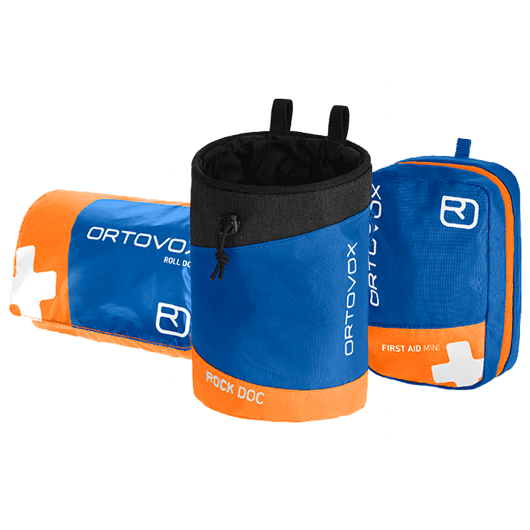
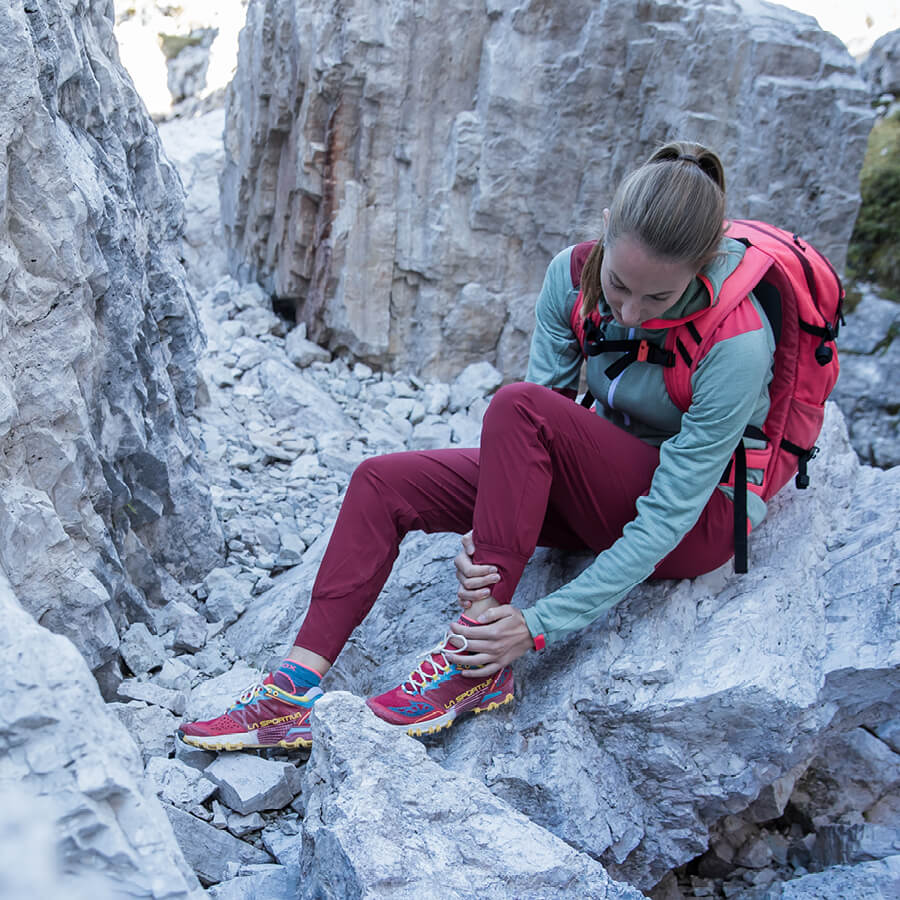
 back
back
Ankle injury
During the approach on a climbing tour your climbing partner stumbles and sprains her ankle. It is swollen, painful and your climbing partner can barely stand on it. A few things are essential if a first responder is to care effectively for the injured person. These basics must be observed. From the three actions given, select the answer which you think is correct. Make sure you put them in the correct order.
Select the appropriate action
I should sit the injured person down comfortably.
First I treat the initial injury, after that I will check the person for other injuries.
Body examination – I should check whether the accident victim has other injuries.
Take a break – instead of continuing, the person should sit down for a while.
Treatment in line with the RICE rule is of no benefit in this case, since it is used for injuries directly to the bone (fractures etc.).
Movement – the affected joint should be put under load and moved immediately to prevent swelling.
Ice – only ice cubes can prevent long-term swelling and need to be placed directly on the skin.
Warmth – I should warm the painful ankle to minimize swelling.
Ice – the ankle should be cooled immediately using an improvised cold pack, since cold reduces pain and prevents swelling.
The only shoe you should not remove is a climbing shoe, because this is so tight fitting it prevents further swelling.
The approach shoe is not removed and the bandage is wrapped tightly around it.
You should remove the approach shoe of the injured person to enable the bandage to be wrapped around the injury directly.
Splinting – only a splint can provide adequate stability to enable the person to continue walking.
Elevation – the foot should be raised to reduce blood pressure and ease pain.
Place foot in a low position – the foot should be below the rest of the body to increase blood circulation and reduce swelling.

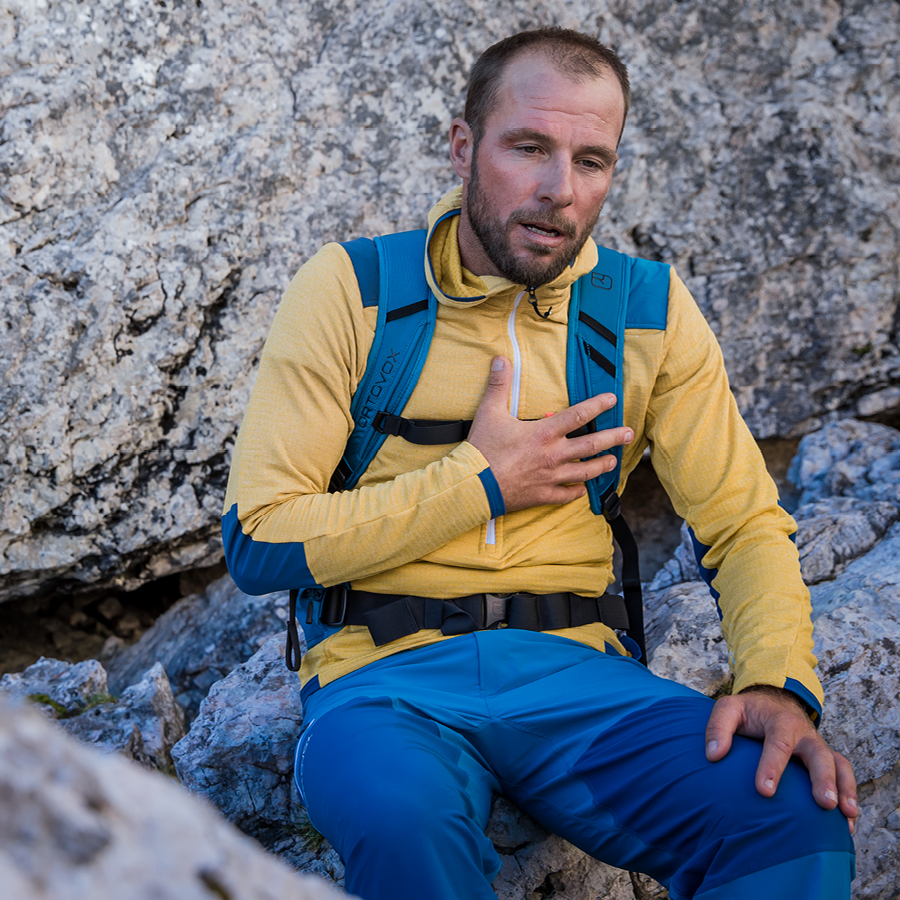
 back
back
Heart attack
Upon arriving at the foot of a rock face on an alpine climbing tour, your climbing partner complains that the approach seemed unusually strenuous, and that he had difficulty breathing and noticed spreading pain in the chest area. He has never had these symptoms before. A few things are essential if a first responder is to care effectively for this person. These basics must be observed. From the three actions given, select the answer which you think is correct. Make sure you put them in the correct order.
Select the appropriate action
You should give your climbing partner a painkiller to relieve the pain.
Rest – your climbing partner should sit down for a while.
First, put on the harnesses and sort out the ropes, after which he will have recovered from the difficult approach climb.
I should carry out an examination of my climbing partner’s body to find out where exactly he is feeling pain.
After resting, we should descend together as quickly as possible.
In order to ease breathing, your climbing partner should remove his backpack, unfasten belts and open any restrictive clothing at the neck.
Make an emergency 112 call, because the ill person is not familiar with the symptoms.
By talking to him, I establish where the symptoms originate and where exactly he has pain.
I don’t make an emergency call, because my climbing partner will probably recover after a rest.
Shock position – elevate the legs to allow blood to flow back into the cardiovascular system and support the heart.
Stable recovery position – it is comfortable and he will be in the correct position should he lose consciousness.
Keep the upper body elevated – this reduces pressure on the heart.
I give him food and drink for strength.
I wrap my climbing partner up warm, talk reassuringly to him and don’t leave him alone.
I don’t wrap him up warm: a slight chill is good because the body uses less oxygen.

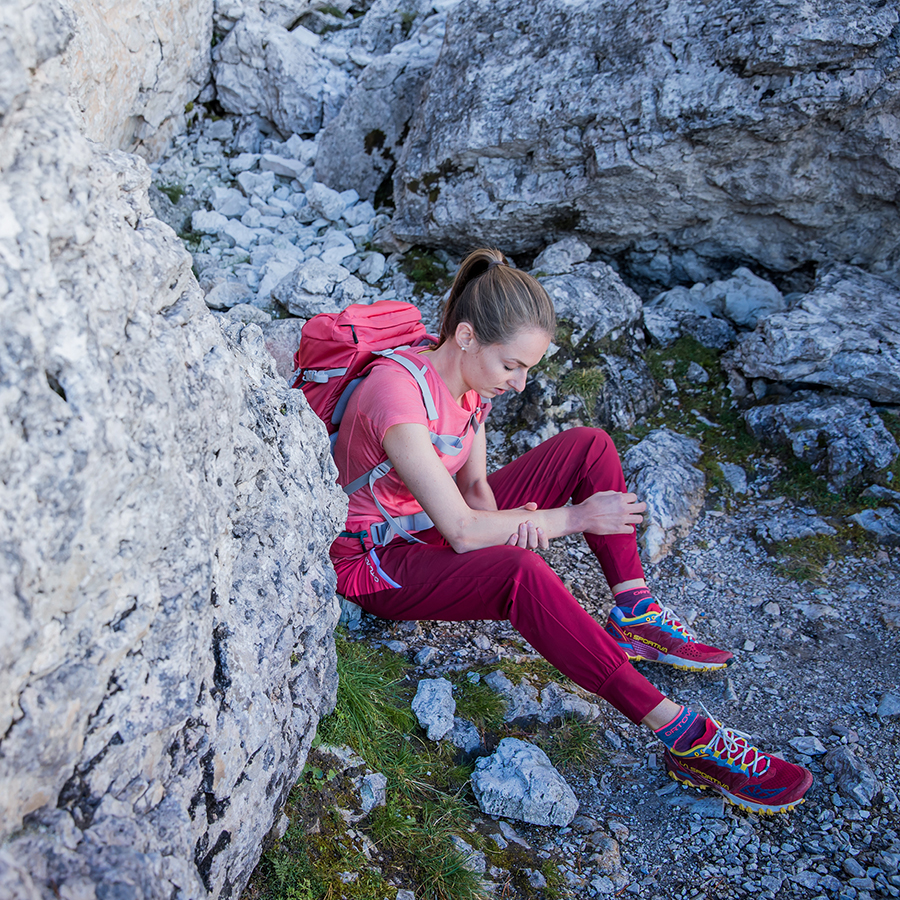
 back
back
Wrist fracture
During the descent on a climbing tour, your climbing partner falls and injures her wrist. The area quickly turns purple and swells up, with the result that she finds moving her fingers painful. How do you act as the first responder and what can you do to ensure you get back to the valley floor without assistance? A few things are essential if a first responder is to care effectively for the injured person. These basics must be observed. From the three actions given, select the answer which you think is correct. Make sure you put them in the correct order.
Select the appropriate action
The injury affects the wrist; since this is quite difficult to break, I should assume it is only bruised.
Body examination – I check whether the accident victim has other injuries.
First I should treat the initial injury, after that I will check the person for other injuries.
I should attempt to realign the broken arm.
RICE – for bone injuries I should follow the RICE rule and treat the injury.
I should attach an aluminum splint for stability.
I should place the arm in a sling to reduce the stress on the fracture site.
Let the limb hang to ensure proper blood supply.
Leave open wounds uncovered, they heal faster in the open air.
We will descend together unaided only if pain and physical condition allow; otherwise I should call the rescue services.
We will definitely descend together, since a fracture is not a life-threatening injury.
I should take no risks with a fracture, evacuation by a professional rescue team is obligatory!


 back
back
Cuts to the head
Your climbing partner has been hit on the temple by a stone. He has a cut which is bleeding profusely. You lower him to the next ledge and rappel down to him. A few things are essential if a first responder is to care effectively for the injured person. These basics must be observed. From the three actions given, select the answer which you think is correct. Make sure you put them in the correct order.
Select the appropriate action
I should put on my disposable gloves.
I should wipe the surface of the bleeding or dirty wound with a sterile compress.
I should apply pressure to the wound using bare hands.
I should clean the wound with antiseptic.
I should wipe the surface of the bleeding or dirty wound with a sterile compress.
I should remove any foreign bodies I can see in the wound.
Place a dressing directly on the wound to soak up the blood.
I should clean the wound with antiseptic.
Cover the wound with a sterile compress from the bandage pack.
The ideal way to wrap a bandage without it slipping is to cross it around the head and under the chin.
As soon as the compress is placed on the wound, the bleeding will stop and a bandage is no longer necessary.
The turban variant is an ideal way to wrap a bandage around the head without it slipping.
If the wound continues bleeding excessively, the legs should be elevated above the head to ensure blood supply to the head is adequate.
If bleeding continues through the dressing, I should apply additional pressure to the bandage using my hand.
I should use a bandage pack as a pressure pad if the wound continues to bleed heavily through the dressing while bandaging.


 back
back
Ankle injury
During the approach on a climbing tour your climbing partner stumbles and sprains her ankle. It is swollen, painful and your climbing partner can barely stand on it. A few things are essential if a first responder is to care effectively for the injured person. These basics must be observed. From the three actions given, select the answer which you think is correct. Make sure you put them in the correct order.
Select the appropriate action
I should sit the injured person down comfortably.
First I treat the initial injury, after that I will check the person for other injuries.
Body examination – I should check whether the accident victim has other injuries.
Take a break – instead of continuing, the person should sit down for a while.
Treatment in line with the RICE rule is of no benefit in this case, since it is used for injuries directly to the bone (fractures etc.).
Movement – the affected joint should be put under load and moved immediately to prevent swelling.
Ice – only ice cubes can prevent long-term swelling and need to be placed directly on the skin.
Warmth – I should warm the painful ankle to minimize swelling.
Ice – the ankle should be cooled immediately using an improvised cold pack, since cold reduces pain and prevents swelling.
The only shoe you should not remove is a climbing shoe, because this is so tight fitting it prevents further swelling.
The approach shoe is not removed and the bandage is wrapped tightly around it.
You should remove the approach shoe of the injured person to enable the bandage to be wrapped around the injury directly.
Splinting – only a splint can provide adequate stability to enable the person to continue walking.
Elevation – the foot should be raised to reduce blood pressure and ease pain.
Place foot in a low position – the foot should be below the rest of the body to increase blood circulation and reduce swelling.


 back
back
Heart attack
Upon arriving at the foot of a rock face on an alpine climbing tour, your climbing partner complains that the approach seemed unusually strenuous, and that he had difficulty breathing and noticed spreading pain in the chest area. He has never had these symptoms before. A few things are essential if a first responder is to care effectively for this person. These basics must be observed. From the three actions given, select the answer which you think is correct. Make sure you put them in the correct order.
Select the appropriate action
You should give your climbing partner a painkiller to relieve the pain.
Rest – your climbing partner should sit down for a while.
First, put on the harnesses and sort out the ropes, after which he will have recovered from the difficult approach climb.
I should carry out an examination of my climbing partner’s body to find out where exactly he is feeling pain.
After resting, we should descend together as quickly as possible.
In order to ease breathing, your climbing partner should remove his backpack, unfasten belts and open any restrictive clothing at the neck.
Make an emergency 112 call, because the ill person is not familiar with the symptoms.
By talking to him, I establish where the symptoms originate and where exactly he has pain.
I don’t make an emergency call, because my climbing partner will probably recover after a rest.
Shock position – elevate the legs to allow blood to flow back into the cardiovascular system and support the heart.
Stable recovery position – it is comfortable and he will be in the correct position should he lose consciousness.
Keep the upper body elevated – this reduces pressure on the heart.
I give him food and drink for strength.
I wrap my climbing partner up warm, talk reassuringly to him and don’t leave him alone.
I don’t wrap him up warm: a slight chill is good because the body uses less oxygen.


 back
back
Wrist fracture
During the descent on a climbing tour, your climbing partner falls and injures her wrist. The area quickly turns purple and swells up, with the result that she finds moving her fingers painful. How do you act as the first responder and what can you do to ensure you get back to the valley floor without assistance? A few things are essential if a first responder is to care effectively for the injured person. These basics must be observed. From the three actions given, select the answer which you think is correct. Make sure you put them in the correct order.
Select the appropriate action
The injury affects the wrist; since this is quite difficult to break, I should assume it is only bruised.
Body examination – I check whether the accident victim has other injuries.
First I should treat the initial injury, after that I will check the person for other injuries.
I should attempt to realign the broken arm.
RICE – for bone injuries I should follow the RICE rule and treat the injury.
I should attach an aluminum splint for stability.
I should place the arm in a sling to reduce the stress on the fracture site.
Let the limb hang to ensure proper blood supply.
Leave open wounds uncovered, they heal faster in the open air.
We will descend together unaided only if pain and physical condition allow; otherwise I should call the rescue services.
We will definitely descend together, since a fracture is not a life-threatening injury.
I should take no risks with a fracture, evacuation by a professional rescue team is obligatory!

ORTOVOX emergency card
LIFE-SAVING INFORMATION FOR FIRST RESPONDERS
Quick and efficient treatment can save lives in an emergency. It’s helpful for first responders and mountain search and rescue to get as much information about the injured person as possible so that they can start treatment at the accident scene. For this reason, we worked together with alpine scientist and expert Walter Würtl to develop the ORTOVOX emergency card. It includes all of the most important information to ensure that first responders and mountain search and rescue can provide the best possible care.
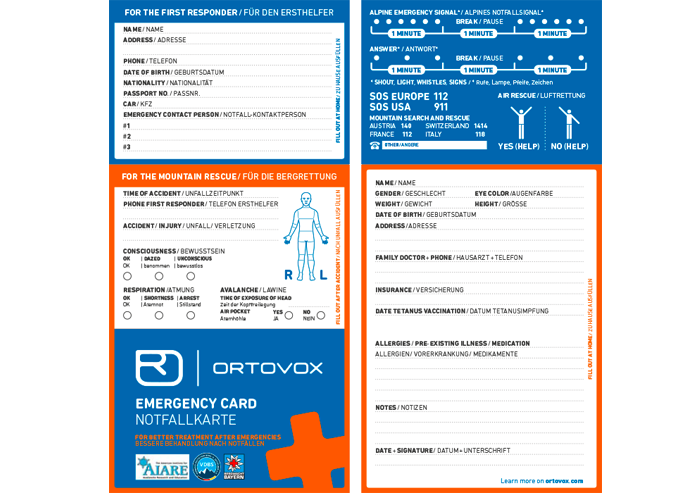
Wir teilen die Notfallkarte in 4 Bereiche auf:
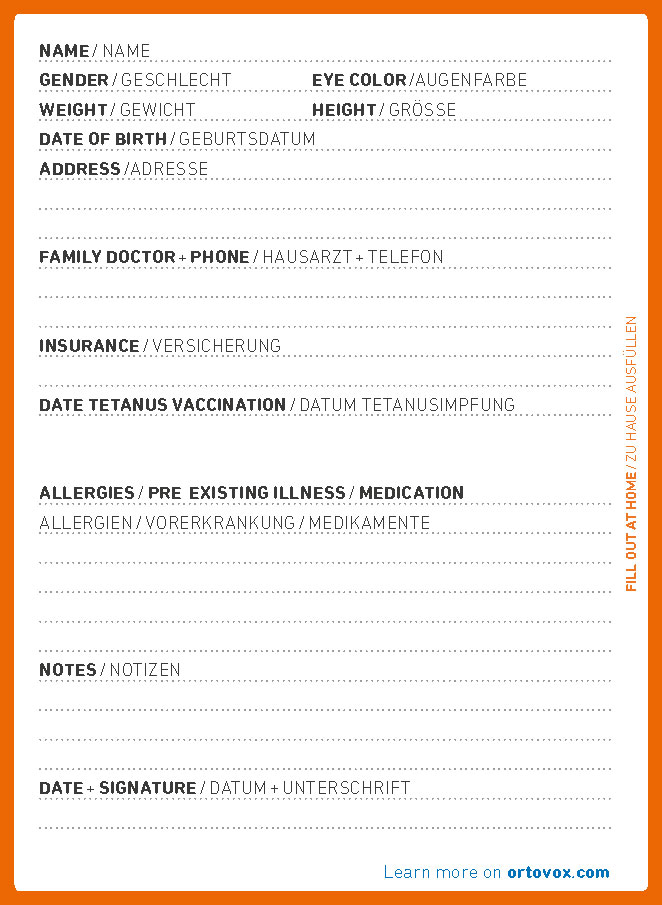
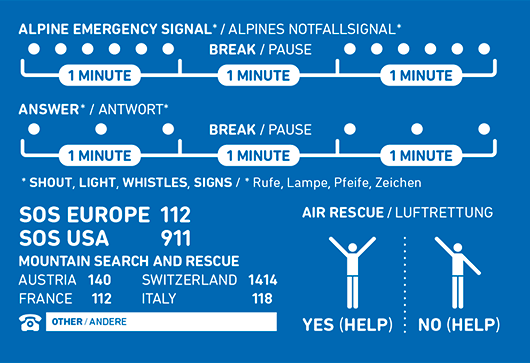
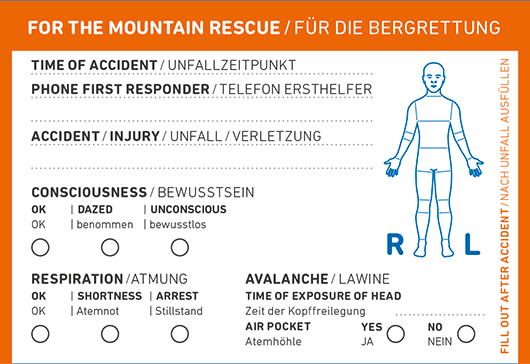
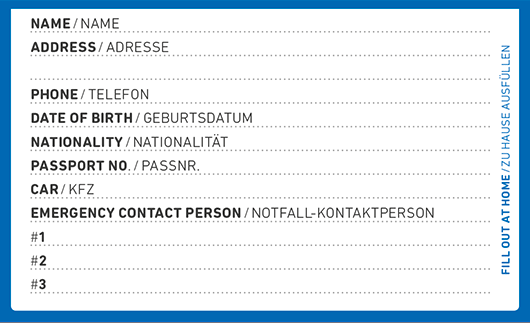

IMPORTANT INFORMATION FOR FIRST RESPONDERS
The mountain climber fills out the emergency card before the climb. They provide their own contact details and medical information as well as the details of their doctor and emergency contact person:

ACTING CORRECTLY IN AN EMERGENCY
The emergency card contains official emergency numbers and illustrates the alpine distress signal.

QUICK OVERVIEW FOR MOUNTAIN SEARCH AND RESCUE
The first responder lists the injuries and most important information about the accident so that mountain search and rescue get a quick overview of the accident victim’s injuries.

FOR FIRST RESPONDERS
The first responder keeps the detachable upper section after the rescue team has arrived. This includes the emergency contacts for them to notify, the victim’s car registration number and other important personal information.
TEAR-RESISTANT
The emergency card is weatherproof: It has a particularly robust coating. Tip: Pencils also work reliably in cold temperatures.;

